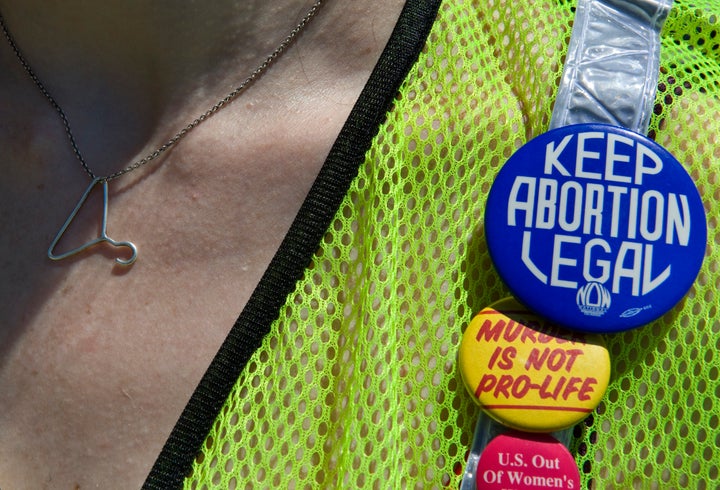
Before 1973′s Roe v. Wade, the problems were dangerous abortions and unequal access to safe abortions. Forty-five years after the landmark Supreme Court case, we still have the problem of unequal access, now exacerbated by a national, coordinated effort to harass women seeking abortions and their providers, both on the street and through a multiplicity of laws.
By the time Roe v. Wade ― and its oft-overlooked companion case, Doe v. Bolton ― reached the Supreme Court, the magnitude of the public health problem was obvious. Obvious too was the fact that poor women and women of color were the most likely to land in emergency rooms (5,000 per year in Chicago’s public hospital, for example), and to die as a result of illegal and self-induced abortions, as I wrote about in 1996′s When Abortion Was a Crime.
In New York City, African-American and Puerto Rican women died due to unsafe abortion at five to 10 times the rate of white women in the 1950s and early 1960s. The racial difference in mortality due to abortion in Georgia was even more dramatic: In 1969, the rate was 14 times higher for black women compared to white women.
At the same time, legal hospital abortions ― therapeutic abortions performed for medical reasons by physicians with anesthesia and antibiotics ― were, in contrast, extremely safe.
Yet in the 1950s and 1960s, only a handful of women could get those safe, legal therapeutic abortions; they were almost exclusively well-to-do white women with private health insurance in private hospitals. Women of color or low-income women who went to public hospitals almost never obtained medical clearance for a legal abortion.
The goal of reform laws enacted in a dozen states in the 1960s, first in Colorado and California ― and including the 1968 Georgia law struck down by Doe v. Bolton ― was to reassure doctors who wanted to perform therapeutic abortions that they acted within the law. Doctors, lawyers, women’s rights organizations and other supporters of reform in the 1960s and 1970s lobbied for abortion reform laws with the hope that they would increase the availability of safe, legal abortions.
Instead, as California’s 1967 reform law showed, the opposite happened. Doctors were more afraid of police and prosecutors going after them; the year before they had seen state officials revoke medical licenses and threaten prosecution of some of the state’s most reputable doctors for performing therapeutic abortions. And instead of allowing an abortion in cases of rape, as permitted by the new law, some local prosecutors rejected these cases, believing the man who denied committing a crime.
Georgia’s 1968 reform law listed multiple steps before a doctor could legally perform an abortion. The abortion would need to take place in an accredited hospital, be approved by an abortion review committee and be endorsed by two additional doctors. This was an obstacle course designed to restrict legal abortions. Noting that state law required nothing similar for any other surgical procedure, the Supreme Court found the Georgia law unconstitutional in Doe v. Bolton. The case was as important as Roe v. Wade because it made it clear that the system of legal abortion created by reform laws violated the rights of both the patient and the physician.
“Aiding and abetting this sexual harassment are elected lawmakers who pass legislation designed to stigmatize and restrict the constitutional rights of women and reproductive health care providers.”
Doe made the development of independent abortion clinics possible. Clinics were preferable to providing abortions in hospitals because they cut the cost of the procedure and moved it out of the obstetrics ward and away from hostile medical personnel. No one predicted then that anti-abortion forces would use the physical independence of the clinics to surround them with protesters and isolate them from their medical colleagues.
There is now jeering, name-calling, jostling, shaming, threatening and worse. The anti-abortion movement has led, trained and reveled in the street harassment of female patients and the workplace harassment of abortion providers for decades. Medical students who want to learn how to provide this necessary part of women’s health care are similarly harassed and silenced, as are their teachers.
Aiding and abetting this gender-based sexual harassment are elected lawmakers who pass legislation designed to stigmatize and restrict the constitutional rights of women and reproductive health care providers.
Sexual harassment is treating a woman like a sexual object to be played with, ridiculed and touched. It’s aim is to demean her and empower the harasser. Insisting that women carry pregnancies to term against their will is to also treat women like objects without regard for their bodies, health or moral decision-making; it is to use their bodies for power and politics.
Laws that require women to see ultrasounds of the developing fetus or listen to a heartbeat are harassment. Requiring vaginal ultrasounds by law prior to every abortion is sexual assault.
Requiring doctors to tell lies about the consequences of abortion is harassment.
Requiring young women to inform parents of abortions knowing ― hoping ― that this will be humiliating and might induce parental rage or violence is harassment.
Today laws are designed to close the doors of specific clinics. This includes forcing hospitals to comply with design requirements or requiring a clinic’s physician to have admitting privileges at a nearby hospital (while allowing hospitals to discriminate against abortion providers.) These are new forms of what Doe found to be unconstitutional. Fortunately, the Supreme Court has struck down some of this legislation, known as targeted regulation of abortion providers, or TRAP laws.
There is other hopeful news, too: young African-American and Latina women are leading the struggle for reproductive justice and sharing their stories to support other women. Funds have been developed in Mississippi to help pay for the cost of travel and child care for women who must travel hundreds of miles to reach the state’s one provider and then stay overnight because of state-mandated waiting periods. Alabama just elected a pro-choice Democrat to the Senate. Five states expanded access to abortion and 11 others expanded access to contraception.
Since 2010, hundreds of laws restricting abortion have been enacted, particularly in the Midwest and South, in states dominated by the Republican Party. The anti-abortion movement ― with its leaders and co-workers in the Catholic and (white) evangelical churches, right-wing nationalist movement, the Republican Party and, too often, some members of the Democratic Party ― have been participating in sexual harassment on a grand scale for decades. It is past time to stop it.
Leslie J. Reagan is a professor of history, law, and gender and women’s studies at the University of Illinois, Urbana-Champaign and the author of When Abortion Was a Crime and Dangerous Pregnancies.
This piece is part of HuffPost’s brand-new Opinion section. For more information on how to pitch us an idea, go here.
